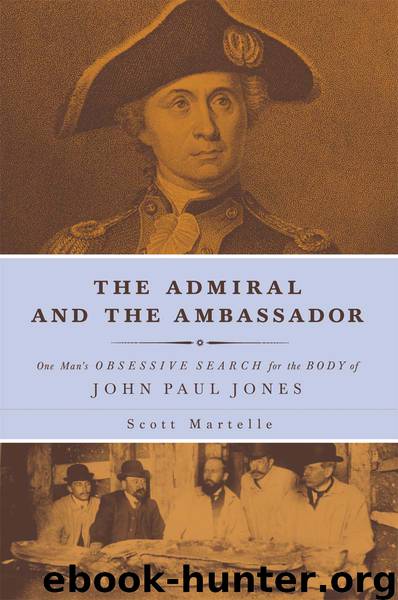The Admiral and the Ambassador by Scott Martelle

Author:Scott Martelle
Language: eng
Format: epub
Publisher: Chicago Review Press
Published: 2014-06-22T16:00:00+00:00
The search began in earnest in late June 1899, with a series of letters and inquiries to various French political figures and bureaucrats. Vignaud, a voracious reader of the Parisian press, had seen an article in the Bulletin Municipal by municipal councilor Alfred Leroux that mentioned Paul Jones and an old cemetery for foreign Protestants on Rue de l’Hôpital Saint-Louis. Vignaud wrote to Leroux asking for more information about that cemetery, including whether it still existed, but there is no mention of a response.12
By the end of the summer, Ricaudy had been enlisted, and his first step was to verify exactly when Jones had died, a date that was still in dispute among historians.13 The logical place to find that detail was in the Hôtel de Ville, but once again, Paris’s revolutionary history got in the way. Those records had been destroyed during the Paris Commune.
Charles Read, the Protestant researcher and historian who had copied Jones’s death information from the city records, died in 1898, the year before Porter began his search. Read’s personal and research papers were donated to the Bibliothèque de Rue des Saints-Pères, a library. Both Bailly-Blanchard and Ricaudy soon found Read’s 1887 article on the history of Protestant cemeteries and Jones’s likely burial spot. Ricaudy took the additional step of consulting Read’s personal archive at the library.
In his early reports to Porter, Ricaudy held back one key detail from the ambassador: that Jones had been buried “in a cemetery for foreign Protestants.” The significance of that withheld fact didn’t become clear until later, even though it wasn’t withheld for very long.14 Bailly-Blanchard had the same material from Read’s article, and he and Porter were becoming convinced they were on the right trail. Porter, whose skepticism of Ricaudy was growing, directed Bailly-Blanchard to undertake a process of elimination of other potential burial sites.
Over the next few weeks, Bailly-Blanchard reviewed more than one hundred publications for hints that their assumption—that Paris was home to only one Protestant cemetery at the time—was correct, and for other clues. They found records that identified Simonneau as the man who had paid for the burial, an act of charity that galled Porter. “This brought to light for the first time the mortifying fact that the hero who had once been the idol of the American people had been buried by charity, and that the payment of his funeral expenses was the timely and generous act of a foreign admirer.” Simonneau was also the king’s commissar overseeing the burial of Protestants, which further cemented Porter’s belief that he was on the right track. And they found that Marron, the minister who had overseen the graveside service, had at that time buried all the dead from his church in Saint Louis cemetery. “I found the book containing the minutes of the meetings of the consistory of M. Marron’s church, but just at the date of Paul Jones’s death, four pages had been torn out,” Porter wrote. He sent Bailly-Blanchard to try to find them, tracking down the heirs of one M.
Download
This site does not store any files on its server. We only index and link to content provided by other sites. Please contact the content providers to delete copyright contents if any and email us, we'll remove relevant links or contents immediately.
| African Americans | Civil War |
| Colonial Period | Immigrants |
| Revolution & Founding | State & Local |
Cat's cradle by Kurt Vonnegut(13866)
Pimp by Iceberg Slim(12931)
Underground: A Human History of the Worlds Beneath Our Feet by Will Hunt(11256)
4 3 2 1: A Novel by Paul Auster(11047)
The Radium Girls by Kate Moore(10907)
American History Stories, Volume III (Yesterday's Classics) by Pratt Mara L(4825)
Perfect Rhythm by Jae(4621)
Wiseguy by Nicholas Pileggi(4586)
The Fire Next Time by James Baldwin(4342)
Paper Towns by Green John(4169)
A Higher Loyalty: Truth, Lies, and Leadership by James Comey(4032)
Pale Blue Dot by Carl Sagan(4001)
The Mayflower and the Pilgrims' New World by Nathaniel Philbrick(3913)
The Doomsday Machine by Daniel Ellsberg(3730)
Too Much and Not the Mood by Durga Chew-Bose(3693)
Killers of the Flower Moon: The Osage Murders and the Birth of the FBI by David Grann(3608)
The Borden Murders by Sarah Miller(3590)
The Sympathizer by Viet Thanh Nguyen(3478)
Killing England by Bill O'Reilly(3455)
